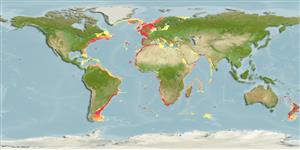Environment: milieu / climate zone / depth range / distribution range
Ecología
marino demersal; oceanodromo (Ref. 51243); rango de profundidad 40 - 600 m (Ref. 7251), usually 100 - 200 m (Ref. 36731). Deep-water; 70°N - 55°S, 82°W - 179°E
Eastern Atlantic: Norway to South Africa (Ref. 6633), including the Mediterranean, Canary Islands, Madeira, Cape Verde, and Tristan da Cunha. Western Atlantic: Newfoundland, Canada and Gulf of Maine to North Carolina, USA (Ref. 7251). Recorded from Uruguay to Argentina (Ref. 9050). Western Indian Ocean: St. Paul and Amsterdam islands (Ref. 6633). Southwest Pacific: New Zealand (Ref. 5755, 9072).
Length at first maturity / Tamaño / Peso / Age
Maturity: Lm 77.9 range ? - 90 cm
Max length : 210 cm TL macho / no sexado; (Ref. 7251); common length : 80.0 cm TL macho / no sexado; (Ref. 3397); peso máximo publicado: 100.0 kg (Ref. 35388); edad máxima reportada: 80 años (Ref. 127279)
Espinas dorsales (total): 10 - 12; Radios blandos dorsales (total): 11-13; Espinas anales 3; Radios blandos anales: 8 - 10. Bluish grey above, paler below with a silvery sheen; fins blackish brown (Ref. 6633). Juveniles have black blotches on head and body (Ref. 6633). Body tall, compressed. Big mouth with big head and a rough bony ridge across upper part of the gill cover (Ref. 35388).
Adults prefer to inhabit caves and shipwrecks (Ref. 27121). Juveniles congregate below floating objects (Ref. 27121). Usually solitary. Feed on large crustaceans, cephalopods and benthic fishes (Ref. 27121). Spawn in the summer (Ref. 35388). Are primary gonochorists (Ref. 58421). Marketed fresh or frozen; eaten steamed, fried, broiled, boiled, microwaved and baked (Ref. 9988). Minimum depth reported from Ref. 6633.
Primary gonochorists (Ref. 58421).
Wheeler, A., 1992. A list of the common and scientific names of fishes of the British Isles. J. Fish Biol. 41(suppl.A):1-37. (Ref. 5204)
IUCN Red List Status (Ref. 130435)
Threat to humans
Harmless
Human uses
Pesquerías: escaso valor comercial; pesca deportiva: si
Más información
ColaboradoresImágenesStamps, Coins Misc.SonidosCiguateraVelocidadTipo de nataciónSuperficie branquialOtolitosCerebrosVisión
Herramientas
Special reports
Download XML
Fuentes de Internet
Estimates based on models
Preferred temperature (Ref.
123201): 5.2 - 19, mean 9.4 °C (based on 672 cells).
Phylogenetic diversity index (Ref.
82804): PD
50 = 0.8125 [Uniqueness, from 0.5 = low to 2.0 = high].
Bayesian length-weight: a=0.01318 (0.00968 - 0.01796), b=3.00 (2.91 - 3.09), in cm total length, based on LWR estimates for this species (Ref.
93245).
Nivel trófico (Ref.
69278): 4.1 ±0.64 se; based on food items.
Resiliencia (Ref.
120179): Bajo, población duplicada en un tiempo mínimo de 4.5-14 años (K=0.05-0.08; tmax=76; tm=9-10 yrs estimated from VBGF; Fec=3 million).
Fishing Vulnerability (Ref.
59153): Very high vulnerability (78 of 100).
Climate Vulnerability (Ref.
125649): Moderate to high vulnerability (50 of 100).
Nutrients (Ref.
124155): Calcium = 9.7 [6.1, 21.1] mg/100g; Iron = 0.354 [0.174, 0.670] mg/100g; Protein = 19.6 [19.0, 20.3] %; Omega3 = 0.427 [0.332, 0.549] g/100g; Selenium = 25 [11, 55] μg/100g; VitaminA = 7.95 [1.81, 35.92] μg/100g; Zinc = 0.253 [0.178, 0.380] mg/100g (wet weight); based on
nutrient studies.
